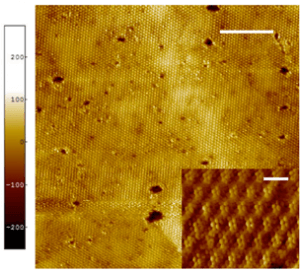Summary
This project advances our ability to characterize and study novel quantum materials, quantum devices, and even individual molecules at the atomic level. By combining Non-Contact Atomic Force Microscopy (NC-AFM), Scanning Tunneling Microscopy (STM) and scanning gate methods, we correlate spatial information with transport properties and can locally manipulate charge, spin and structural states. This opens a unique and useful window on the physics of 2D materials, 1D systems such as carbon nanotubes and 0D objects like quantum dots and molecules. We will collaborate with Adam Wei Tsen’s group to study surface electronic transport properties of 2D materials and correlate these with their bulk transport characteristics. We will also apply STM and Scanning Tunneling Spectroscopy (STS) to achieve atomic-scale resolution imaging of single molecules in collaboration with David Cory’s group. We expect this project will create a unique capability to probe and manipulate matter at the atomic scale, leading to accelerated development of novel transistors and spintronic devices, quantum sensors, ultra-high density classical and quantum information storage, and novel qubit applications.

Figure 1. Topographic image of exfoliated 1T-TaS2 at 77 K (scale bar = 20 nm) obtained in the scanning tunneling microscope. The colour scale is in picometers. The periodic structure resolved in the main image is a charge density wave known to occur in this material. Inset: magnified image showing both the charge density wave and the underlying atomic lattice (scale bar = 1.4 nm).
Related Content
Quantum Sensing Applications using Quantum Communication Technology
Summary The Quantum Encryption and Science Satellite provides a platform to develop and deploy quantum sensing and metrology via photonic channels. This project will build upon ‘free-space’ quantum communication technology and explore new approaches and methods to advance two primary applications: quantum-enhanced telescopes, and spectroscopic sensing for methane detection in the atmosphere. For the […]
December 8, 2018

Quantum Simulation of Strongly Coupled Field Theories
Strongly-coupled field theories describe both fundamental and applied quantum problems.
August 10, 2017

Quantum Sensing with Small Quantum Systems
Summary There are small quantum systems over which we have very good control and which have long lifetimes. Examples include the phosphorous (P) defect in silicon (Si) and the nitrogen vacancy (NV) defect in diamond. With P defect in Si, we focus on improving our understanding of the hyperpolarization mechanism to better enable engineering of […]
December 1, 2016

Towards large area, resonant quantum tunneling diodes by continuous Langmuir transfer of exfoliated 2D materials
Summary Atomically thin 2D materials constitute promising building blocks for quantum devices due to their exotic, layer-dependent electronic properties. The ability to stack these materials in alternating layers enables heterostructures to be built in almost limitless combinations and over small enough length scales to observe quantum phenomena. So far though, practical implementation of devices based […]
April 1, 2020

